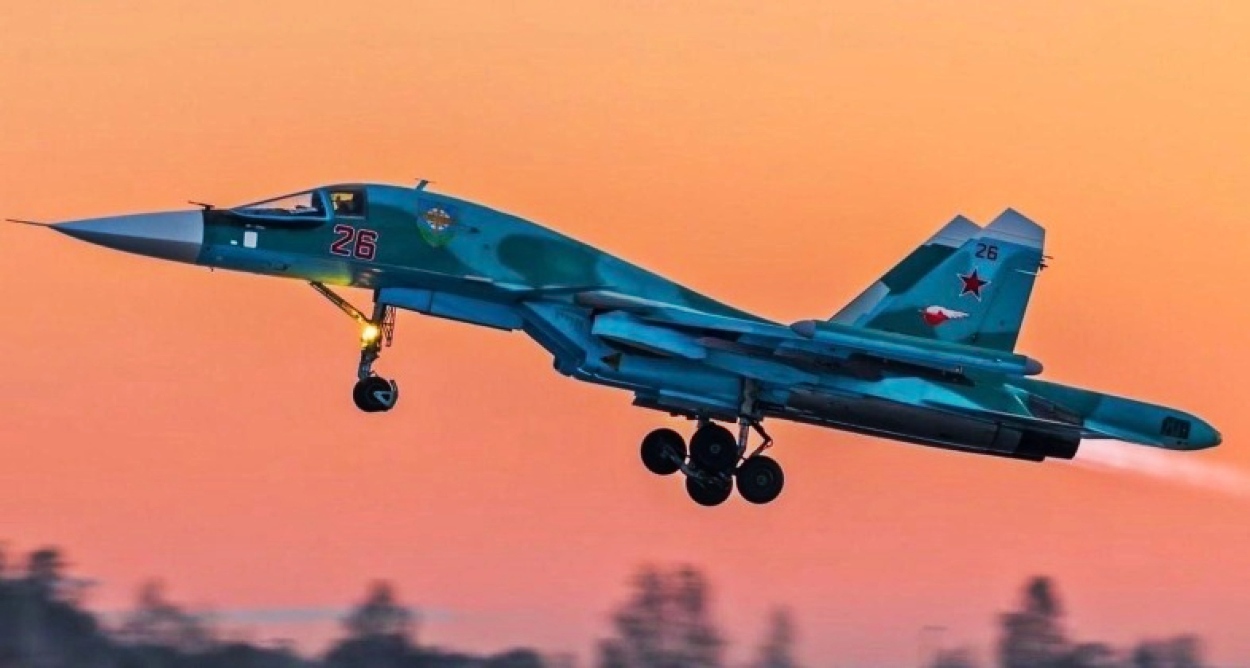Russia has begun using a large and powerful cluster munition on Ukrainian ground formations, causing severe damage and stunning Kyiv’s military.
Leading Russian and Ukrainian Telegram channels claim this is the first wartime use of the RBK-500, with a video showing a massive chain of simultaneous explosions on a long stretch of Ukrainian countryside in south Donetsk.
An air-dropped bomb, the munition’s persistent use might see massive Ukrainian casualties on their positions or staging points once they are identified by aerial or ground surveillance.
While it has not been specified, an informed guess can be made that the bombs were released from the Su-34 fighter bomber. Whether it is being attached to the Universal Module for Planning and Correction (UMPC) glide bomb kit is not known.
Video Shows Chain Blasts
The video showed footage from an overhead unmanned aerial vehicle (UAV) showing three large chain blasts. Many posts on leading Russian Telegram groups claim the place to be Staromayorskoye in southern Donetsk.
Assuming it is dropped from the UMPC kit, it gives Russia a massive tactical battlefield advantage in the winter. The UMPC also guides Russia’s FAB-500 drop bombs. Ukraine, too, uses guided glide bombs, like the US-made Joint Direct Attack Munition (JDAM).
The Russian glide bombs allow Moscow to destroy Ukrainian targets behind the frontline without the fear of the munition being shot down. This is due to the absence of radio frequency emissions that make it immune to air defense systems.
The RBK-500 fused with a UMPC can help tackle ground positions across an extensive frontage of at least 2 kilometers, halting any accumulation or staging for a counterattack. Current production levels of the bomb are not known, but it can be assumed that Russia has sufficient numbers in stock to have periodic mass effects on the frontline.
However, precise details on how the RBK-500 is used and its inventory with the Russian Aerospace Forces are unclear, with RuMoD publicity material possibly shedding more light in the coming weeks.
South Donetsk ‘Hot’
On Monday, Ukraine’s General Staff reported a Russian attack near Staromayorske but maintained that Moscow’s forces experienced “no success.” Also, on November 20, Russia’s Ministry of Defense (RuMoD) said it had blocked a Ukrainian attempt to move units of forces around Staromayorske and neighboring villages, including Rivnopil. Ukraine said it had captured Rivnopil in late June.
The day prior, on November 19, Moscow had said it had thwarted a Ukrainian counterattack around Staromayorske as Kyiv tried to rotate troops near the village and the settlement of Urozhaine.
Its Vostok Group of Forces in “cooperation with ground-attack, Army aviation and artillery struck the manpower and hardware of the Ukrainian 79th Air Assault, 58th Motorised Infantry Brigades and the 127th Territorial Defense Brigade close to Novomikhailovka, Nikolskoye, Shevchenko, Konstantinovka, Novodonetskoye, Staromayorskoye in southern Donetsk People’s Republic.”
Again, on November 20, it claimed that the Vostok Group, “supported by artillery…thwarted the enemy’s attempt to launch a counterattack at Novomikhailoka (where) AFU infantry was neutralized.”
This was followed by “foiling six Ukrainian attempts to rotate units close to Staromayorskoye, Ravnopol, and Chervonoye,” which saw the destruction of Ukrainian “motor vehicles and manpower.”
⚡️The first recorded use of five-hundred-kilogram RBK-500 cluster bombs by the 🇷🇺Russian military in the Donetsk region pic.twitter.com/xsIbDrlHWW
— 🇺🇦Ukrainian Front (@front_ukrainian) November 19, 2023
The Russians then undertook a “large scale” strike on Staromayorskoye among others (Novomikhailovka, Ugledar, Konstantinovka, Novodonetskoye, Urozhaynoye) using “operational-tactical aviation, missile troops and artillery inflicted fire damage on clusters of manpower and hardware of the Ukrainian Mechanized, 79th Air Assault, 58th Motorised Infantry and the 127th Territorial Defense Brigades.” The use of the RBK-500 seems to have taken place during this time.

Battlefield Stagnant
The reports came amid a largely static battlefield situation on the frontlines in eastern and southern Ukraine, owing to heavy rainfall setting in after disappointing gains for Kyiv in its long-awaited summer counteroffensive. Wet weather conditions could prevent both sides from undertaking large-scale offensive operations until winter fully sets in.
Russia has maintained a defensive posture, with only local offensives to take small towns and improve its tactical positions. It has, however, been actively striking Ukrainian positions with artillery (both gun and tube rocket), helicopter gunships like the Ka-52 Kamov, infantry and First Person View (FPV) drone strikes on Ukrainian positions, low altitude air raids by Su-25 Frogfoot jets and battlefield interdiction ground attacks by Su-34 fighter-bombers.
So far, Moscow has not shown signs of any offensive. Still, it aims to degrade Ukrainian material and manpower resources through an active defense posture.
- The author can be reached at satamp@gmail.com
- Follow EurAsian Times on Google News